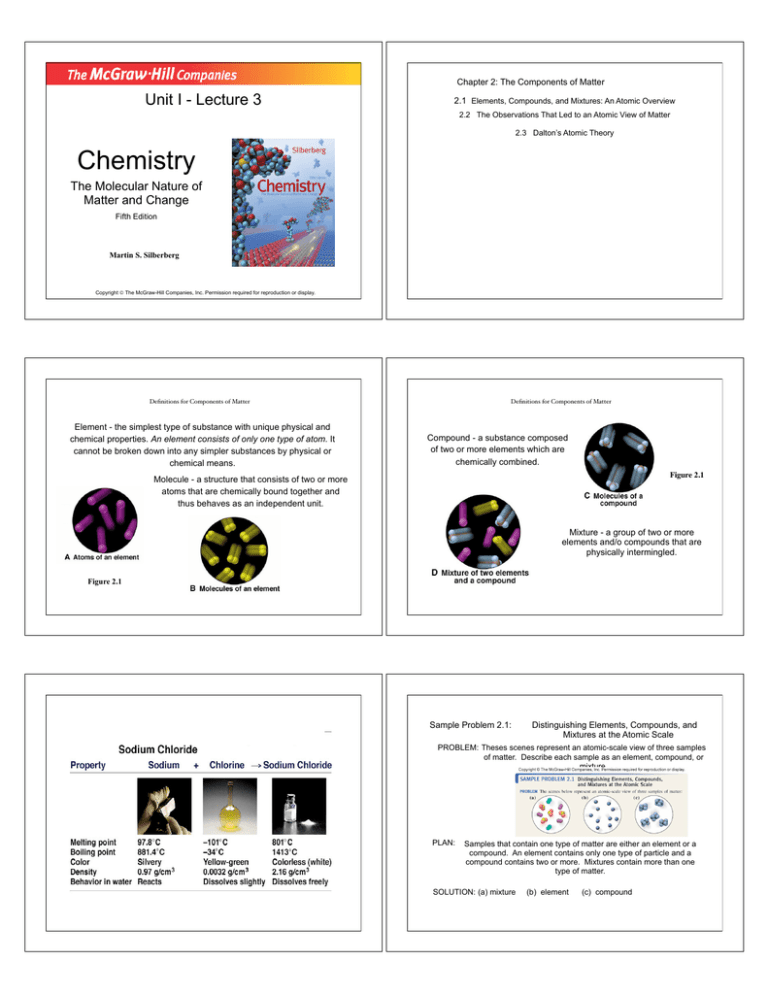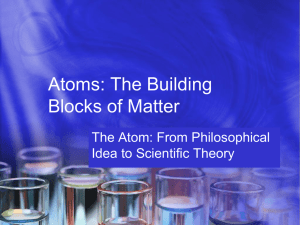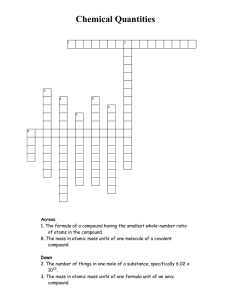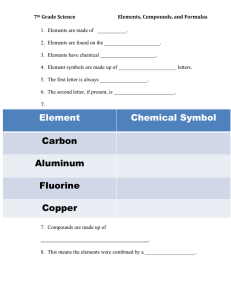advertisement

Chapter 2: The Components of Matter Unit I - Lecture 3 2.1 Elements, Compounds, and Mixtures: An Atomic Overview 2.2 The Observations That Led to an Atomic View of Matter 2.3 Dalton’s Atomic Theory Chemistry The Molecular Nature of Matter and Change Fifth Edition Martin S. Silberberg Copyright ! The McGraw-Hill Companies, Inc. Permission required for reproduction or display. Definitions for Components of Matter Element - the simplest type of substance with unique physical and chemical properties. An element consists of only one type of atom. It cannot be broken down into any simpler substances by physical or chemical means. Definitions for Components of Matter Compound - a substance composed of two or more elements which are chemically combined. Figure 2.1 Molecule - a structure that consists of two or more atoms that are chemically bound together and thus behaves as an independent unit. Mixture - a group of two or more elements and/o compounds that are physically intermingled. Figure 2.1 Sample Problem 2.1: Distinguishing Elements, Compounds, and Mixtures at the Atomic Scale PROBLEM: Theses scenes represent an atomic-scale view of three samples of matter. Describe each sample as an element, compound, or mixture. PLAN: Samples that contain one type of matter are either an element or a compound. An element contains only one type of particle and a compound contains two or more. Mixtures contain more than one type of matter. SOLUTION: (a) mixture (b) element (c) compound The law of mass conservation: mass remains constant during a chemical reaction. Figure 2.2 Law of Mass Conservation The total mass of substances does not change during a chemical reaction. reactant 1 + reactant 2 product total mass calcium oxide + carbon dioxide CaO + CO2 56.08 g + 44.00 g Sample Problem 2.2 Figure 2.3 = total mass calcium carbonate CaCO3 100.08 g Calculating the Mass of an Element in a Compound Law of Definite !or Constant" Composition PROBLEM: No matter the source, a particular compound is composed of the same elements in the same parts (fractions) by mass. PLAN: Calcium carbonate The mass ratio of uranium/pitchblende is the same no matter the source. We can use the ratio to find the answer. SOLUTION: Analysis by Mass (grams/20.0 g) Mass Fraction (parts/1.00 part) 8.0 g calcium 2.4 g carbon 9.6 g oxygen 20.0 g Percent by Mass (parts/100 parts) 0.40 calcium 0.12 carbon 0.48 oxygen 40% calcium 12% carbon 48% oxygen 1.00 part by mass 100% by mass Analysis of 84.2 g of the uranium containing compound pitchblende shows it is composed of 71.4 g of uranium, with oxygen as the only other element. How many grams of uranium can be obtained from 102 kg of pitchblende? mass (kg) of uranium = mass (kg) uranium in pitchblende mass (kg) pitchblende x mass (kg) pitchblende If elements A and B react to form two compounds, the different masses of B that combine with a fixed mass of A can be expressed as a ratio of small whole numbers. Example: Carbon Oxides A & B Carbon Oxide I : 57.1% oxygen and 42.9% carbon Carbon Oxide II : 72.7% oxygen and 27.3% carbon Assume that you have 100 g of each compound. In 100 g of each compound: g O = 57.1 g for oxide I & 72.7 g for oxide II g C = 42.9 g for oxide I & 27.3 g for oxide II gO gC gO gC = = 57.1 42.9 72.7 27.3 mass (kg) of uranium mass (g) of uranium 71.4 kg uranium = 86.5 kg = 102 kg pitchblende x 84.2 kg pitchblende uranium 86.5 kg uranium x Law of Multiple Proportions mass (kg) of pitchblende 1000 g kg = 8.65 x 104 g uranium Dalton’s Atomic Theory The Postulates 1. All matter consists of atoms. 2. Atoms of one element cannot be converted into atoms of another element. 3. Atoms of an element are identical in mass and other properties and are different from atoms of any other element. = 1.33 = 4. Compounds result from the chemical combination of a specific ratio of atoms of different elements. 2.66 2.66 g O/g C in II 1.33 g O/g C in I = 2 1 Dalton’s Atomic Theory Dalton’s Atomic Theory explains the mass laws explains the mass laws Mass conservation Definite composition Atoms cannot be created or destroyed postulate 1 or converted into other types of atoms. postulate 2 Since every atom has a fixed mass, and each atom has a specific mass. postulate 4 postulate 3 during a chemical reaction atoms are combined differently, and therefore, there is no mass change overall. Dalton’s Atomic Theory Each element has a fixed fraction of the total mass in a compound. Sample Problem 2.3: explains the mass laws PROBLEM: Multiple proportions Atoms of an element have the same mass Atoms are combined in compounds in specific ratios postulate 3 Visualizing the Mass Laws Theses scenes represent an atomic-scale view of a chemical reaction. Which of the mass laws: mass conservation, definite composition, or multiple proportions is (are) illustrated? postulate 3 and atoms are indivisible. postulate 1 When different numbers of atoms of elements combine, they must do so in ratios of small, whole numbers. PLAN: Mass conservation illustrated if number of each atom before and after reaction remains constant. Definite composition illustrated by formation of compounds that always have the same atom ratio. Different compounds made of same elements have small whole number ratios of those elements illustrates multiple proportions. SOLUTION: Seven purple and nine green atoms in each circle, mass conserved. One compound formed has one purple and two green, definite composition. Law of multiple proportions does not apply.




